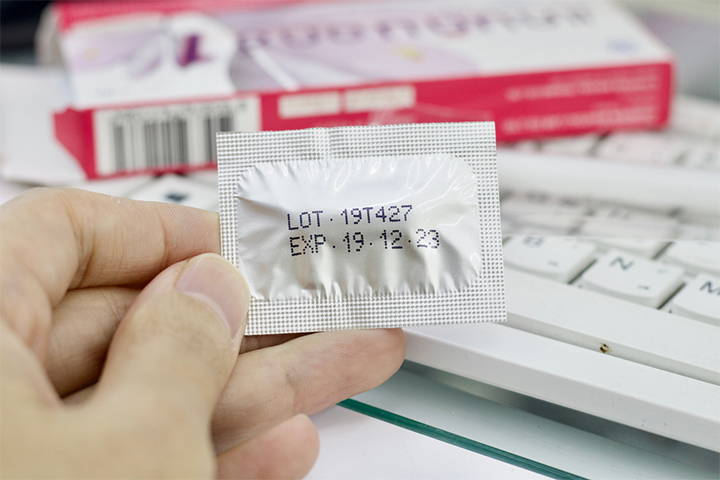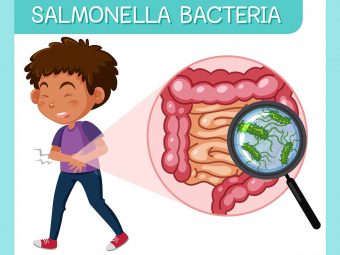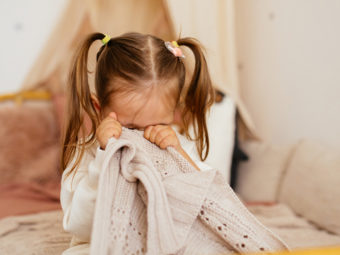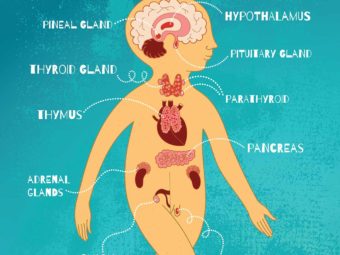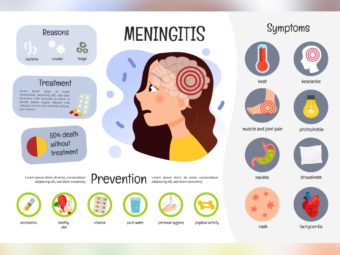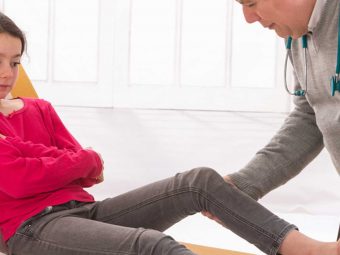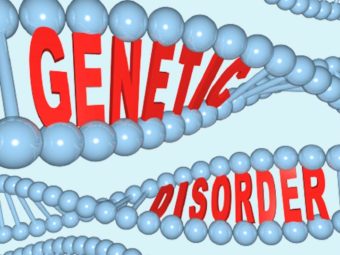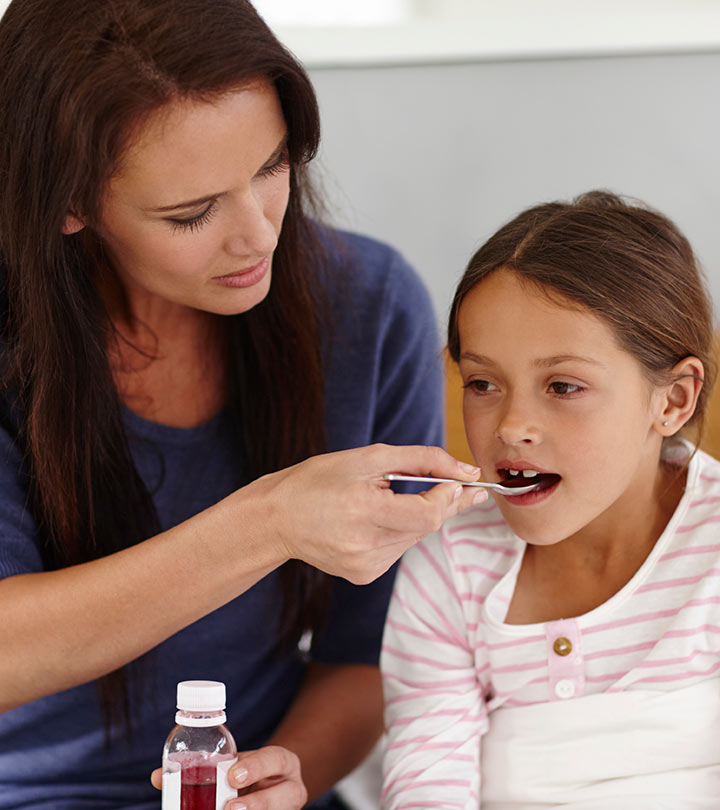
Image: iStock
Acetaminophen or paracetamol in children is used to relieve pain or fever. It is a common medicine found in every household. Doctors generally prescribe it for adults and children. Paracetamol usually does not have any side effects.
However, you should always seek a doctor’s advice for the right medicine dosage. The dose for children varies with age, and paracetamol is effective only when given in the right dosage. In case of overdose, the drug might cause side effects.
Read the post to know about the right dosage of paracetamol for children of different ages, its benefits, and some side effects.
Is Paracetamol (Acetaminophen) Safe For Kids?
Yes. Paracetamol is often the first line of treatment preferred by doctors and parents to treat fever and provide pain relief (1). It is an over-the-counter analgesic available under many brand names including Tylenol, Calpol, and Panadol in the US, and Crocin and Paracip in India.
When administered in the right doses, it can help in treating a number of ailments. People have been using paracetamol for several years to treat pain caused due to an injury or an illness. The drug is well tolerated by the children of all ages and has few or no side-effects when used in the recommended doses.
When Should You Give Paracetamol To Your Child?
Paracetamol is commonly used for:
- Fever: A dose of just 10-15mg of paracetamol can cause the temperature to drop. However, doctors may recommend against using this antipyretic medicine for low fevers (temperatures below 101 degrees Fahrenheit).
Image: IStock
- Headaches: Sometimes, a high temperature can cause body pains, headache and general discomfort in the child. A paracetamol dose can help reduce the fever and alleviate the symptoms. The drug usually reduces the severity of the pain, but does not remove it.
- Paracetamol is commonly prescribed as a pain management medication, as it aids in alleviating mild to moderate pain. In addition, by relieving body pains, headaches, toothache, or tummy pain, the drug also helps your child get a good night’s sleep.
- Symptoms of cold and flu might reduce when you give the child paracetamol. However, you cannot treat a common cold or flu with the drug.
Image: IStock
- A fever is a common side-effect of immunization. If the child gets a vaccine shot, your doctor may recommend paracetamol to bring down the temperature.
- Pain caused due to a sprain in the body can also be reduced with paracetamol.
- Adolescents may also take the drug on the first two days of their period to alleviate the pain associated with dysmenorrheaiXA condition marked by frequent, severe cramping and discomfort during periods .
If the child has a high fever or unbearable pain in the body, paracetamol may not help. The drug also does not help clear nasal congestion.
Paracetamol Dosage For Children
The manufacturer’s recommended dosage, mentioned on the label, is usually around 160mg/5ml. Below we give the age-appropriate paracetamol dose for children.
Paracetamol for infants and babies
You can also give paracetamol for babies aged three months or older. The dosage (2) you need to give depends on the age of the baby. The ideal option here would be the paracetamol suppository for babies, rather than tablets or syrups. However, it is best to take the doctor’s advice:
| Child’s Age | 3-6 months | 6-24 months |
| Dose | 60mg | 120mg |
| Oral Suspension/Syrup | 2.5ml | 5ml |
DO NOT give paracetamol to infants aged less than three months unless recommended by the pediatrician particularly for low infant fevers. Always make sure you give no more than the prescribed dosage.
Paracetamol for toddlers and younger kids
Image: Shutterstock
Toddlers can be susceptible to various allergies and inflammation, which may arise from exposure to allergens or infections, leading to a fever. In addition, fever might also manifest as a symptom of strain, exposure to hot or cold climates, or when a child gets an immunization shot. During such times, you can give the child a dose of paracetamol to bring down the fever. However, it is important to note that paracetamol is not typically a non-steroidal anti-inflammatory drug; therefore, you may use this chart as a reference and talk to your child’s healthcare specialist before giving the medicine to your child.
| Age | 2-4 years | 4-6 years |
| Dose | 180mg | 240mg |
| Oral Suspension(120mg/5ml) | 7.5ml | 10ml |
The medicine should be given in four separate doses in 24 hours.
Paracetamol for children above six years
Unfortunately, most parents do not pay attention to the dosage recommendations nor do they consult their doctors. This can lead to paracetamol overdosing even in children.
Here is a reference chart that you can use when you need to give the child this analgesiciXA drug that lowers or relieves pain (3).
| Approximate Age | 6-8 years | 8-10 years | 10-12 years |
Dose | 240-250mg | 360-375mg | 480-500mg |
|---|---|---|---|
| Oral Suspension(250mg/5ml) | 5ml | 7.5ml | 10ml |
Paracetamol for teens
Teens and older children are given adult doses of paracetamol. So, for teenagers, you can give one tablet of 200mg. Make sure that the medication dosage is as prescribed by the doctor to prevent overdosing.
How Long Does Liquid Paracetamol Take To Act On Children?
Liquid paracetamol, whether syrup or soluble tablets, starts to take effect about 30 minutes after taking the medication. You may consider giving the medicine to your child with or without food (4).
What To Do Before Every Dose Of Paracetamol For Children?
If syrup, shake the bottle well for at least ten seconds before giving it to the child. If your child seems to dislike the taste of the medicine, have them drink milk or fruit juice right after the syrup.
In the case of paracetamol tablets, make them swallow the tablet with water, juice, or milk. For dissolvable paracetamol tablets, ensure they are completely dissolved in the water before giving them to your child.
For suppositories, follow the instructions on the medicine leaflet and gently push the medicine into your child’s bottom (5).
Side-Effects Of Paracetamol
Side-effects are uncommon, but when they happen they may require medical attention. Here are some of them:
- An allergic reaction like a rash or swelling.
Image: IStock
- Flushing, blood pressure change and an increase in heartbeat.
- Long-term effects of blood disorders such as leukopeniaiXA condition where the body's white blood cell count is below normal and thrombocytopeniaiXA condition that arises when the blood's platelet count is too low .
- An overdose of paracetamol can lead to liver and kidney damage, which can be fatal in some cases.
Besides these, if you see any unusual symptoms in the child after using paracetamol, take him or her to the doctor immediately.
Precautions To Prevent Paracetamol (Acetaminophen) Poisoning
As paracetamol is one of the most commonly used drugs in a house, chances of overdosing or poisoning are high if you don’t pay attention to the dosage. Here are some of the precautions you must take to prevent an accidental overdose.
- Do not combine paracetamol, ibuprofen, or any other pediatric medication unless specifically directed by the doctor.
- Given that we always have a stock of paracetamol at home, we could end up with expired medications. So always check for the expiry date on the strip or bottle before using it. If the date of expiry is not visible or not mentioned, do not use it.
Image: Shutterstock
- Do not take the tablet out of the foil or pour the syrup into the spoon or cup until the child is ready to take medicine.
- Always keep the paracetamol tablets out of your children’s reach.
- To avoid confusion, always make a note of the doses of paracetamol given to the child during the day.There should be a gap of at least six hours between doses. Do not give more than four doses a day. If your child’s fever or pain becomes worse or doesn’t recede even after 48 hours of taking the paracetamol, visit the doctor immediately.
 Quick tip
Quick tipFrequently Asked Questions
How long can children take paracetamol for?
It is advisable not to extend the use of paracetamol in children beyond three days without consulting a doctor to ensure child safety (5).
Is paracetamol safe for children under two years old?
Paracetamol may be given to babies as young as three months old in the form of suspension and suppositories (2) (4). Tablets are usually meant for children six years and above (5). However, you should consult a pediatrician to know the correct dose for your child.
How long does it take for paracetamol to take effect in children?
Paracetamol tablets and syrups may take about 30 minutes to show effects. However, suppositories may take up to an hour to work fully (4).
What are the alternatives to paracetamol for children?
Ibuprofen may be used as an alternative to paracetamol in children above three months. However, the medication is not suitable for children with asthma (7).
Pediatricians may prescribe paracetamol for children to treat fever or pain. It is safe and well-tolerated by children if given in the proper doses. Although it is available over the counter, you may contact the child’s pediatrician to know the dosage guidelines and duration based on the child’s age, weight, and general health. Children above three months of age and older children and teens may require similar amounts. Avoid overdosing since it has the potential to damage the liver, and always keep the medication away from the child’s reach.
Infographic: Precautions To Prevent Paracetamol (Acetaminophen) Poisoning
German surnames are derived from words and phrases of various cultures, civilizations, and occupations in the country. Check out this infographic for some of the common surnames in Germany and their meanings. Illustration: Momjunction Design Team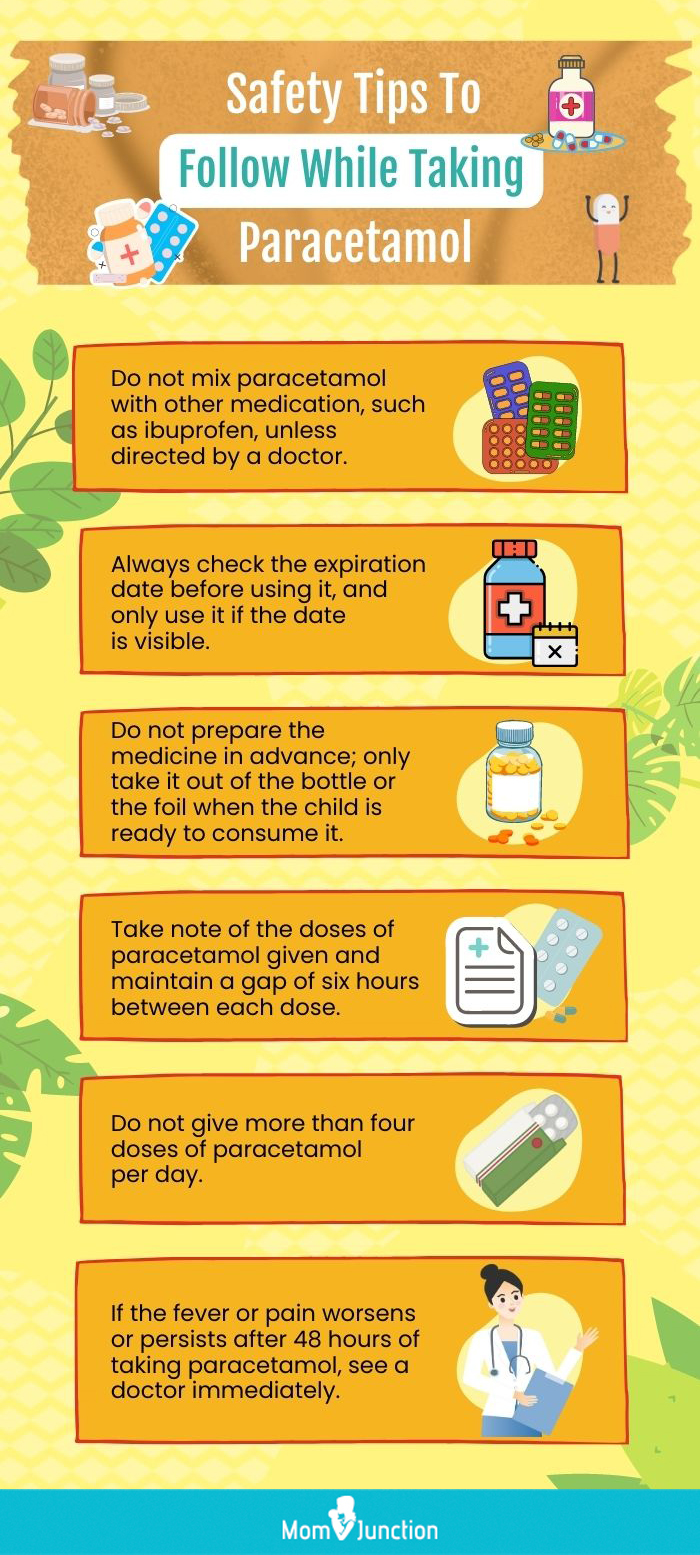
Key Pointers
- Administering the right dosage is crucial for the effectiveness of Paracetamol, a common medication for pain and fever.
- Recommended dosage of Paracetamol rarely has any side effects.
- Paracetamol can relieve pain, headaches, and cold or flu symptoms.
- The ideal dosage for children depends on their age and should only be given after consulting a medical professional.
- Paracetamol may cause rare side effects like an allergic reaction and increased heart rate; prolonged use can lead to liver and kidney damage.
References
- N Cranswick and D Coghlan; (2000); Paracetamol efficacy and safety in children: the first 40 years.
https://pubmed.ncbi.nlm.nih.gov/11319581/ - Paracetamol 120mg/5ml Oral Suspension.
https://www.medicines.org.uk/emc/medicine/10741#gref - Paracetamol for children (including Calpol).
https://www.nhs.uk/medicines/paracetamol-for-children/ - About paracetamol for children.
https://www.nhs.uk/medicines/paracetamol-for-children/about-paracetamol-for-children/ - How and when to give paracetamol for children.
https://www.nhs.uk/medicines/paracetamol-for-children/how-and-when-to-give-paracetamol-for-children/# - Taking paracetamol for children with other medicines and herbal supplements.
https://www.nhs.uk/medicines/paracetamol-for-children/taking-paracetamol-for-children-with-other-medicines-and-herbal-supplements/ - Medicines for children: a guide.
https://raisingchildren.net.au/guides/a-z-health-reference/medications





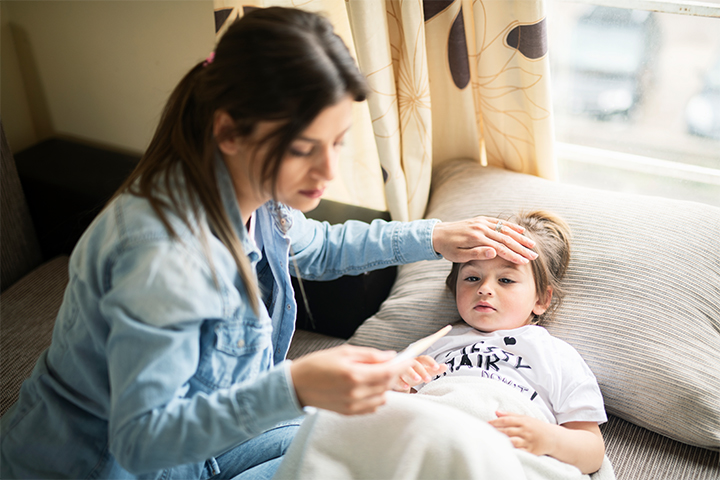
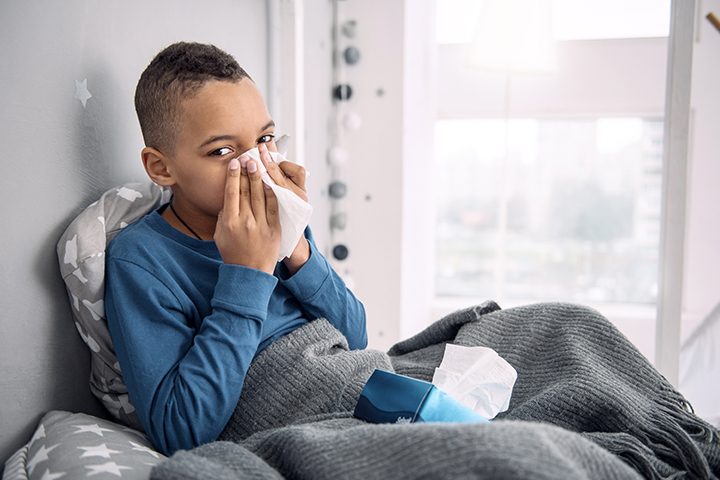


 Point to consider
Point to consider